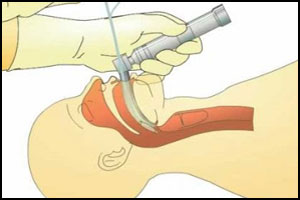- Home
- Editorial
- News
- Practice Guidelines
- Anesthesiology Guidelines
- Cancer Guidelines
- Cardiac Sciences Guidelines
- Critical Care Guidelines
- Dentistry Guidelines
- Dermatology Guidelines
- Diabetes and Endo Guidelines
- Diagnostics Guidelines
- ENT Guidelines
- Featured Practice Guidelines
- Gastroenterology Guidelines
- Geriatrics Guidelines
- Medicine Guidelines
- Nephrology Guidelines
- Neurosciences Guidelines
- Obs and Gynae Guidelines
- Ophthalmology Guidelines
- Orthopaedics Guidelines
- Paediatrics Guidelines
- Psychiatry Guidelines
- Pulmonology Guidelines
- Radiology Guidelines
- Surgery Guidelines
- Urology Guidelines
Obesity associated with difficult intubation management by laryngoscopy: BMC

Obesity is a serious disorder and may bring about many difficulties of perioperative management. Now, a new study published in the BMC Anesthesiology indicates the same. According to the study, obesity is associated with an increased risk of difficult intubation, difficult laryngoscopy and Mallampati score ≥ 3 in adults patients undergoing general surgical procedures.
Shaoqiang Huang, Department of Anaesthesia, Obstetrics & Gynecology Hospital, Fudan University, Shanghai, China, and colleagues conducted the systematic review to assess the association between obesity and difficult intubation.
For the study, the researchers searched electronic databases for related reviews and references of meta-analyses on August 14, 2017. The databases of PubMed, Embase, and the Cochrane controlled trials register were searched compared obese with non-obese patients in which difficult intubation rate of the adult population were retrieved. Patients with a BMI ≥ 30 kg·m− 2were considered obese. The primary outcome was difficult tracheal intubation; secondary outcomes were the rates of difficult laryngoscopy and Mallampati score ≥ 3. This review included 204,303 participants in 16 studies.
Read Also: Updated ESA guidelines for pre-operative evaluation in Obesity
Key Findings:
- There was a statistically significant association between obesity and risk of difficult tracheal intubation (pooled RR = 2.04, 95% CI: 1.16–3.59, p = 0.01; I2 = 71%, p = 0.008, Power = 1.0).
- It also showed significantly association between obesity and risk of difficult laryngoscopy (pooled RR = 1.54, 95% CI: 1.25–1.89, p < 0.0001; I2 = 45%, p = 0.07, Power = 1.0), obesity and risk of Mallampati score ≥ 3 (pooled RR = 1.83, 95% CI: 1.24–2.69, p = 0.002; I2 = 81%, p < 0.00001, Power = 0.93).
- There were no association of obesity and risks of difficult intubation compared with non-obesity in the cohort studies (pooled RR = 3.41, 95% CI: 0.88–13.23, p = 0.08; I2 = 50%, p = 0.14) and the elective tracheal intubation (pooled RR = 2.31, 95% CI: 0.76–6.99, p = 0.14; I2 = 73%, p = 0.01), no associated with an increased risk of difficult laryngoscopy in the sniffing position (pooled RR = 2.00, 95% CI: 0.97–4.15, p = 0.06; I2 = 67%, p = 0.03).
"Obesity was associated with an increased risk of difficult intubation, difficult laryngoscopy and Mallampati score ≥ 3 in adults patients undergoing general surgical procedures. However, there was no association of obesity and risks of difficult intubation compared with non-obesity in the cohort studies and the elective tracheal intubation, no associated with an increased risk of difficult laryngoscopy in the sniffing position. Future analyses should explore the association of BMI and difficult airway," concluded the authors.
For further information follow the link: https://doi.org/10.1186/s12871-018-0534-4

Disclaimer: This site is primarily intended for healthcare professionals. Any content/information on this website does not replace the advice of medical and/or health professionals and should not be construed as medical/diagnostic advice/endorsement or prescription. Use of this site is subject to our terms of use, privacy policy, advertisement policy. © 2020 Minerva Medical Treatment Pvt Ltd